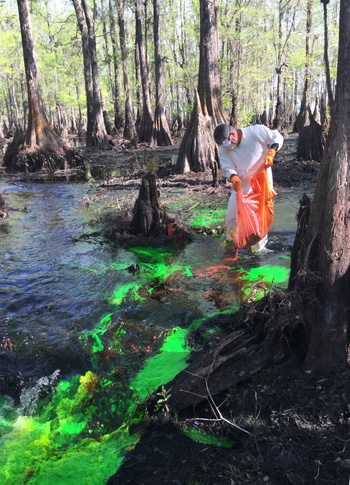Beneath Florida’s cities and swamps lies a complex network of karst conduits. The same chemical weathering that carves truck-sized tunnels through the calcium carbonate rock also leads to sinkholes at the surface. For Florida insurance agents, sinkholes are a headache. But for the state’s hydrogeologists, every sinkhole is an opportunity to understand the aquifer below.
Sinkholes allow surface water, as well as contaminants, to flood into an aquifer. By mapping the network of entry points and exit springs, hydrogeologists can better understand the underground system and better protect drinking water at the source. That understanding is important to populations outside Florida: Karst aquifers provide drinking water for 25% of people on Earth.
Isotope analysis helps hydrogeologists trace water origins, but the technique’s use has generally been limited to sinkhole lakes and springs no more than 4 kilometers apart. Recently, however, a team in Florida used isotope ratios to connect points 32 kilometers apart. It’s the farthest hydraulic connection between a sinkhole and a spring yet documented and the first connection involving a first-magnitude spring (those discharging an average of 100 cubic feet—2.8 cubic meters—of water per second).
“Dyeing” to Know

“Normally, for hydrogeology, we only care about subsurface water flows,” explained Ming Ye, a hydrogeologist at Florida State University and a coauthor of the research, published in Groundwater in April. But when studying sinkholes, he said, scientists have to consider surface water flows, too.
In 2010, two sinkholes appeared at the edge of Lake Miccosukee in north central Florida, and in 2018 Ye and his colleagues used a technique called dye tracing to detect water flows from sinkhole to spring.
Dye tracing requires guesswork, Ye said. It’s “like hunting a treasure.”
Florida Geological Survey technicians poured lime-green fluorescein dye into the sinkholes, then placed monitors at likely outflow sites downslope. None detected the diluted dye. The researchers also placed cheaper charcoal packets at less likely locations. One of those sites, Natural Bridge Spring, 32 kilometers away, turned up evidence of the dye.
Heavy Signatures
Connecting the dots with dye was only step one. The team next explored whether isotopes could also establish the hydraulic connection.
Isotope signatures are a common method for assessing groundwater origins. A small percentage of oxygen molecules are 18O, “heavy isotopes” that evaporate less readily than common 16O isotopes, giving lake signatures a substantially higher proportion of 18O than groundwater or rainfall. Knowing the isotope signatures of the sinkhole, spring, and groundwater, the researchers determined that roughly 8.5% of Natural Bridge Spring water originated at Lake Miccosukee.
That mixing fraction was based on pairs of water samples. Using weekly water samples, the researchers compared isotopes from Natural Bridge Spring to isotopes collected earlier at Lake Miccosukee. They found that the dye reached the spring 18 days after application at Lake Miccosukee, and the presence of the dye at Natural Bridge Spring peaked at day 34. Removing the effects of rainfall, the isotope ratios at both sites were perfectly correlated 35 days apart, demonstrating a hydraulic connection and validating the expected transit time.
Connecting Dots Underground
The researchers now plan to reverse the process, tying a spring back to its source and using isotopes as a primary confirmation method.
By collecting regular water samples from area springs and sinkhole lakes, researchers can look for isotope ratio trends over time. Possible connections can be confirmed with dye tracing. The method would remove the guesswork of dumping dye into a sinkhole and expand the understanding of the karst aquifer at lower cost and effort, researchers said.
“What they’re exposing here is a very sound method to backtrack type of infiltration,” said Joanna Doummar, an assistant professor of hydrogeology at American University of Beirut who was not involved in the research.
Using isotopes to connect the dots allows hydrogeologists a wider window of sampling and evidence. “[Dye] tracing is very important, but it’s very static,” said Doummar. “It doesn’t tell you how this is varying through time.”
Ultimately, knowledge of the subsurface system will help water managers protect spring water at its upslope entry point. Knowing the transit time and mixing fraction will also help managers gauge threats, as contaminants may decay or dilute while traveling through the aquifer.
“It’s really important, given the heterogeneity of this infiltration, to detect all these areas and identify all the transit times,” Doummar said. “With the assumptions that [Ye and his team] have taken, which are very legitimate, they have exposed a method to backtrack the percentage of water coming from the sinkhole.”
Until the system is developed, Ye and his collaborators will continue treasure hunting. A 1,618-hectare Florida lake completely drained into a sinkhole in early June, offering another chance to explore the aquifer with bags of organic dye.
—J. Besl (@J_Besl), Science Writer






